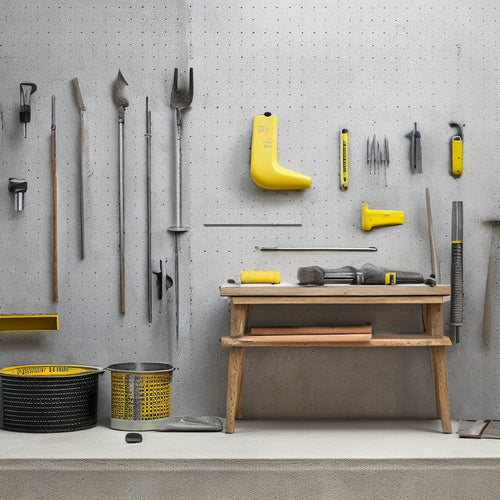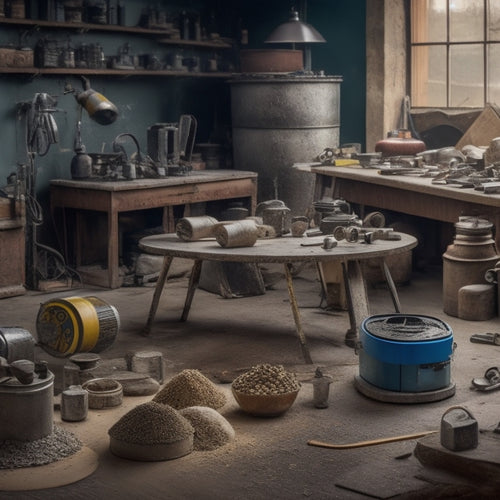
3 Best Tools for Concrete Block Steps Installation
Share
You'll need a sturdy trowel, level, and measuring tools to guarantee accurate calculations and precise cuts for your concrete block steps installation. Additionally, a heavy-duty mixer is essential for efficiently combining mortar ingredients, and don't forget critical safety gear like protective eyewear, durable gloves, and a dust mask/respirator. With these three key tool categories in place, you'll be well on your way to constructing sturdy and visually appealing steps. As you move forward with your project, you'll discover the importance of each tool and how they work together to achieve a professional-grade finish.
Key Takeaways
• A sturdy trowel is essential for scooping, spreading, and smoothing mortar during concrete block steps installation.
• A level ensures accurate horizontal and vertical alignment of steps, with options including spirit level or laser level.
• Measuring tools like tape measures and squares are vital for precise calculations and cuts.
• Mixing equipment, such as a mixing stick or drill with mixing paddle, saves time and energy when combining mortar ingredients.
• Safety gear, including protective eyewear, durable gloves, and steel-toed boots, is crucial for protecting workers during installation.
Essential Hand Tools Required
You'll need a sturdy trowel to scoop, spread, and smooth the mortar, as it's the primary tool for laying concrete block steps. Its curved blade and comfortable grip will help you achieve a consistent layer of mortar.
Next, you'll require a level to guarantee your steps are perfectly horizontal and vertical. A spirit level or laser level will do the trick.
Measuring tools, such as a tape measure and a square, are also vital for accurate calculations and precise cuts.
Don't forget a mixing stick or drill with a mixing paddle attachment for mixing the mortar. This mixing equipment will save you time and energy.
A bucket or wheelbarrow will come in handy for mixing and transporting the mortar.
Finally, a pointing trowel and a jointer will help you finish the joints and edges of the concrete blocks.
With these essential hand tools, you'll be well-equipped to tackle the task of installing concrete block steps.
Heavy-Duty Equipment Needed
For large-scale concrete block steps installation, a heavy-duty mixer is necessary to efficiently combine and blend the mortar ingredients, ensuring a consistent and strong bond between the blocks. This equipment is essential for mixing large volumes of mortar, which is vital for constructing a sturdy and durable staircase.
You'll also need excavation machinery, such as backhoes or excavators, to dig and prepare the site for the concrete block steps. These machines will help you remove dirt, rocks, and other debris, creating a stable foundation for your project.
In addition to a heavy-duty mixer, you'll need concrete mixers to transport and pour the mixed mortar into the block cavities. These mixers come in various sizes, ranging from small, portable units to large, truck-mounted machines.
When choosing a concrete mixer, consider the size of your project, the type of concrete you're working with, and the distance you need to transport the mixed material.
Safety Gear for Protection
Operating heavy-duty equipment and handling concrete blocks and mortar mixtures can expose you to hazardous conditions, making it essential to wear important safety gear to protect yourself from potential injuries. As you work on concrete block steps installation, you'll be handling heavy blocks, mixing mortar, and using power tools, which can lead to accidents if you're not properly equipped.
First and foremost, you'll need protective eyewear to shield your eyes from flying debris, dust, and other particles. Look for eyewear with impact-resistant lenses and a snug, comfortable fit.
Next, invest in durable gloves that provide grip, protection, and flexibility. These will help you maintain control of heavy blocks and tools while protecting your hands from abrasions and cuts.
Additionally, consider wearing a dust mask or respirator to prevent inhaling dust and airborne particles. Steel-toed boots, a hard hat, and a first-aid kit should also be part of your safety arsenal.
Frequently Asked Questions
Can I Use a Regular Hammer for Concrete Block Steps Installation?
When it comes to concrete block steps installation, you'll want to choose the right hammer for the job.
While you might be tempted to use a regular hammer, it's not the best option.
You'll need a hammer specifically designed for masonry work, such as a rubber mallet or a dead blow hammer, to avoid damaging the blocks or dislodging the mortar.
These specialized hammers will help you achieve the precise installation techniques required for a sturdy and long-lasting structure.
Do I Need to Seal the Concrete Blocks After Installation?
Did you know that 80% of concrete damage occurs due to water infiltration? You're wise to wonder if sealing the concrete blocks after installation is necessary.
Sealing provides a protective barrier against moisture, reducing the risk of cracks and damage. You'll benefit from increased durability, improved appearance, and reduced maintenance.
Use a silane-based sealer and apply it using a low-pressure sprayer or roller, ensuring even coverage. Proper sealing techniques will give your concrete blocks a longer lifespan.
Can I Install Concrete Block Steps on Uneven Ground?
You're wondering if you can install concrete block steps on uneven ground. The short answer is yes, but you'll need to prioritize foundation preparation.
To guarantee stability, you'll need to employ leveling techniques, such as excavating and filling with compacted gravel or sand. This will create a solid base for your steps.
Additionally, consider using a layer of geotextile fabric to prevent settling and shifting.
With proper prep, you can achieve a sturdy and safe installation.
How Long Does It Take to Complete a Concrete Block Steps Project?
When planning a concrete block steps project, you'll want to establish a realistic project timeline. This depends on several factors, including the size of the steps, site preparation, and your installation efficiency.
On average, a small to medium-sized project can take around 2-5 days, while larger projects may require 1-2 weeks.
To guarantee a smooth process, break down the project into manageable tasks, and allocate sufficient time for each stage to maintain quality and efficiency.
Are Concrete Block Steps Suitable for Areas With High Foot Traffic?
'When it rains, it pours' - and with high foot traffic, you're right to wonder if concrete block steps can withstand the deluge.
Durability concerns are valid, but with proper installation and maintenance, they can hold their own. Regular cleaning and sealing will help prevent wear and tear.
Additionally, applying a non-slip coating and repairing cracks promptly will guarantee the steps remain safe and sturdy.
Conclusion
You've got the essentials, the heavy-hitters, and the safety net.
Now, you're ready to tackle concrete block steps installation like a pro.
With your trusty trowel, level, and hammer by your side, you'll lay each block with precision and care.
Your compactors, mixers, and saws will help you power through the heavy lifting.
And, with your hard hat, gloves, and goggles, you'll protect yourself from harm.
You've got the right tools for the job – let's get building!
Related Posts
-

10 Must-Have Tools for Concrete Repair Organization
You'll need a solid organization system to keep your concrete repair tools and materials within easy reach, protected...
-

Top DIY Concrete Grinding and Polishing Tools
When selecting DIY concrete grinding and polishing tools, you'll want to take into account a range of factors to guar...
-

7 Must-Have Tools for Concrete Repair Organization
To effectively organize your concrete repair projects, you'll need a thorough toolkit that includes a well-planned st...


